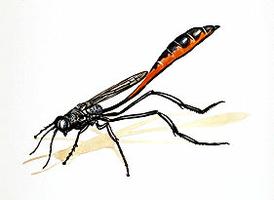Wasp is a term applied to stinging insects in the division Aculeata of the order Hymenoptera, which also includes ants and bees. In common usage, a number of parasitic and gall-forming Hymenoptera (division Parasitica) are also referred to as wasps. This terminology is rather loose when it comes to discussing these insects scientifically. This article approaches the subject entomologically.
All wasps generally have an abdomen somewhat narrowed at the base (the so-called wasp-waist), a body with simple hairs (contrasting with the branched hairs of bees) and an ovipositor that may be modified into a sting. Most wasps have 2 pairs of membranous wings, although some forms are wingless. Wasps vary in size from tiny parasites, or parasitoids, less than 1 mm long to large predators 35 mm long. These insects are distributed throughout Canada.
Aculeata
The division Aculeata includes some 500 species of stinging wasps, and it has been suggested that another 200 or so have yet to be recorded by entomologists. Velvet ants (family Mutillidae) are parasites of ground-nesting wasps and bees. They live mostly in arid areas of southwestern Canada. They are brightly coloured, hairy wasps; the wingless females can give a very painful sting.
The mud daubers (family Sphecidae) are often conspicuous. They gather pellets of mud that they fashion into nest cells and provision with spiders or grasshoppers as food for their young. In the same family as mud daubers are thread-waisted wasps, digger wasps, sand wasps and others. These too are predatory and catch a diversity of prey, including grasshoppers, true bugs, flies, ants and bees. It is the females of all these wasps that capture and sting their prey, then take it back to their nests where they lay eggs on the living but paralyzed prey. The wasp larvae hatch and devour the prey.
Included in the family Vespidae are the social wasps, which are perhaps the best known Aculeates after the bees. The familiar paper nests constructed by these insects house complex societies of a few dozen (eg, the open comb, paper nests of genus Polistes commonly seen under the eaves of houses and garages) to over a thousand individuals, as in hornets and yellow jackets. They are mostly predatory, but may often be found feeding on nectar from flowers and floral buds.
Parasitica
The diversity of parasitic and gall wasps in Canada is great. The number of known species is about 6000, but rises to an estimated 16 000 or more if those that are still unknown are included. Unlike most parasites, the parasitic wasps kill their hosts in feeding. Thus, they are often referred to as parasitoids.
Such a large and diverse insect group exhibits great variation in lifestyles and habitats. Most of the tiny parasitic wasps are quite poorly known. They attack immature stages of butterflies and moths (caterpillars and pupae) and a variety of other insects, including beetles, true bugs, aphids and flies. The larvae of a few species feed on their hosts that have been paralyzed by the egg-laying female from the outside (ectoparasitically), but most feed endoparasitically after the eggs are laid within the host. Some, such as the family Trichogrammatidae, are so small as to be able to develop within a single egg of a moth.
Among the ichneumon wasps (family Ichneumonidae) are larger species often recognized by their elongate and threadlike ovipositors. As a family, they are very diverse in size, and most feed endoparasitically on caterpillars or pupae. Again, the biology of most species is poorly known.
There are numerous other families of parasitic wasps in some 8 superfamilies. The gall wasps (family Cynipidae) are not parasitoids, but live in characteristic galls on plant leaves and stems, in which their larvae feed and develop. It is the presence of the cynipid eggs and larvae that causes the plant to grow the characteristic gall. Often, a complex of other insects becomes associated with the galls and the larval cynipids.
Relationship with Humans
Most wasps are beneficial, being parasites or predators of other insects. A number of species of parasitoids are reared and released for the biological control of insect pests for crop and forest protection.

 Share on Facebook
Share on Facebook Share on X
Share on X Share by Email
Share by Email Share on Google Classroom
Share on Google Classroom




